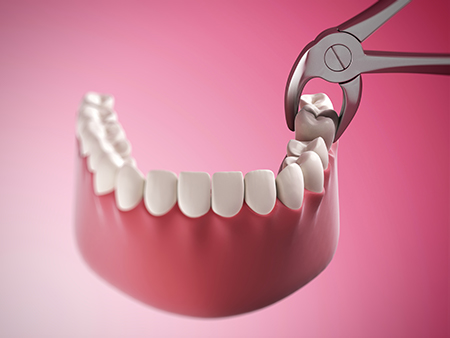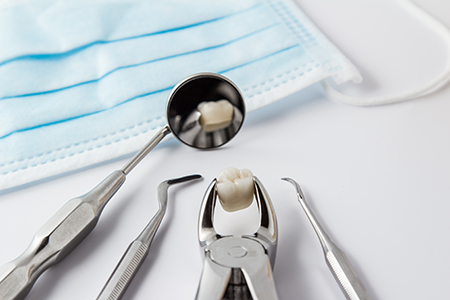We speak English, Spanish and Portuguese
We speak English, Spanish and Portuguese

At Inspirational Smiles, our priority is preserving your natural teeth whenever possible, but there are occasions when removing a tooth is the most responsible option for long‑term oral health. An extraction can stop the spread of infection, remove a source of pain, or make room for healthier development in a child’s mouth. We focus on careful assessment and clear communication so patients understand why extraction is being recommended and what comes next.
Teeth are not removed lightly. Before recommending an extraction, we explore all viable alternatives — restoration, endodontic therapy, or periodontal treatment — and explain why these options may not be appropriate in a specific case. When removal is the best course, we tailor the plan to the complexity of the case and the needs of the patient, including appropriate pain control and follow‑up care.
Understanding the reasons behind an extraction helps reduce anxiety and supports better outcomes. Below are common scenarios that frequently lead to a recommendation for extraction; each item describes the clinical concern and how removal supports overall oral health.
An over‑retained primary (baby) tooth that hampers permanent tooth eruption
Primary teeth normally loosen and fall out as permanent teeth erupt. Occasionally a baby tooth remains anchored to the jaw because its roots did not resorb or it has become fused to bone. When that happens, the retained tooth can delay or deflect the emergence of the permanent tooth and interfere with normal alignment, so extraction is often recommended to allow proper development.
A permanent tooth with irreparable decay
Dental decay begins in the outer enamel and can progress to destroy supporting structure and infect the tooth’s nerve. When a tooth has lost too much structure to be predictably rebuilt, or if infection has compromised the tooth and surrounding bone, removal may be the safest option to protect adjacent teeth and overall health.
Severe fractures that leave the tooth non‑restorable
Teeth can sustain cracks and breaks of varying degrees. If a fracture extends below the gumline, into the root, or involves a pattern that cannot be reconstructed, extracting the tooth may be necessary to prevent ongoing pain and infection.
Advanced periodontal disease weakening tooth support
When gum disease has caused significant loss of the bone and soft tissues that hold a tooth in place, the tooth may become mobile or painful. In advanced cases where stabilization is not possible, extraction can be part of a treatment plan to restore oral health and prevent further damage.
Impacted or problematic third molars (wisdom teeth)
Wisdom teeth are the last to erupt and often lack sufficient space, becoming impacted or causing damage to neighboring teeth. If a third molar is decayed, misaligned, or likely to cause future problems, removal may be recommended sooner rather than later to avoid complications.
Extractions to support orthodontic treatment
In some orthodontic cases, removing one or more permanent teeth creates the space needed to align the bite and achieve a stable, functional result. Extractions are carefully planned in coordination with the orthodontic team to meet treatment goals.

A successful extraction begins with a thorough review of your medical and dental history. We’ll ask about medications, recent illnesses, and any conditions that could influence healing. Certain health issues or blood‑thinning medications require specific planning or coordination with your physician to keep care safe.
We routinely use digital radiographs to evaluate root shape, surrounding bone, and any nearby structures. These images help determine whether a simple removal is appropriate or if surgical techniques will be needed. We’ll discuss anesthesia choices as well — from local numbing to options for sedation for patients who prefer extra relaxation — and provide clear pre‑operative instructions to follow the day of the procedure.
Before moving forward, your dentist will explain the recommended approach, the expected recovery timeline, and replacement options if a tooth will be missing after extraction. Informed consent and an opportunity to ask questions are integral parts of our process so you feel prepared and confident before treatment begins.
When a tooth is fully visible in the mouth and the roots are accessible, a simple extraction is often possible. After numbing the area thoroughly with a local anesthetic, the tooth is loosened and removed using specialized instruments. The procedure is usually quick, and most patients experience minimal discomfort during the appointment.
We take steps to maximize comfort throughout the visit, including discussing additional sedation options for anxious patients. If stitches are needed, we will place them and schedule any necessary follow up to ensure proper healing.
Surgical extractions are indicated when a tooth is broken at the gumline, impacted, fused to bone, or when root anatomy makes removal more challenging. This procedure may involve a small incision, removal of a portion of bone, or sectioning the tooth to allow gentle, controlled removal. Local anesthesia is provided, and sedation can be arranged if needed.
For particularly complex surgical cases, we may refer to or collaborate with an oral and maxillofacial surgeon to ensure the highest standard of care. Regardless of setting, every surgical plan prioritizes tissue preservation and predictable healing.

Recovery varies with the complexity of the extraction, but good habits speed healing and reduce complications. Immediately after the procedure you’ll be given instructions tailored to your case. These guidelines cover steps to control bleeding, manage discomfort, limit swelling, and protect the developing clot in the socket.
Generally, you can expect some soreness and swelling for a few days. Following our recommendations for rest, gentle oral hygiene, and activity modification helps the tissue heal and lowers the risk of problems such as dry socket. We’ll also schedule follow‑up appointments as needed to monitor your progress.
If you notice unexpected symptoms — persistent heavy bleeding, worsening pain, or signs of infection — contact us so we can assess the situation promptly and intervene if necessary.
Control bleeding with firm pressure
Bite gently on the gauze pad placed over the extraction site for the time recommended by your dentist. This pressure encourages clot formation and reduces bleeding. Replace the gauze as directed and avoid excessive spitting that can dislodge the clot.
Protect numb tissues
Until sensation returns, avoid chewing on the side of the extraction and take care not to bite your lips, cheeks, or tongue, which can be numb and more easily injured.
Follow medication instructions
Antibiotics:
If prescribed, complete the full course as directed to reduce the risk of infection.
Pain management:
Taking an analgesic before the local anesthetic wears off can help minimize discomfort. Use over‑the‑counter or prescription pain medication exactly as instructed.
Protect the clot to promote healing
Avoid rinsing vigorously, sucking through straws, or smoking in the early healing phase. These actions can dislodge the clot and lead to delayed healing or dry socket.
Limit swelling with cold therapy
Apply an ice pack to the cheek near the surgical site in short intervals (for example, 10 minutes on, 10 minutes off) during the first 24 hours to minimize swelling.
Avoid tobacco
Smoking or using tobacco products impairs circulation and tissue repair; refrain from these for at least the first week after extraction to support reliable healing.
Choose gentle foods and stay hydrated
Eat soft, cool foods initially and avoid very hot or spicy items. Maintain hydration with non‑carbonated, non‑alcoholic beverages.
Resume oral care carefully
Keep the mouth clean while avoiding direct disturbance of the extraction site. After the first day or two, gentle rinsing with a mild saline solution can help refresh the area without harming the clot.
Attend follow‑up visits
Return for any scheduled post‑operative checks. If sutures were placed or the case was complex, these visits let us confirm that healing is progressing as expected.
If you experience persistent bleeding, increasing pain, or other concerning signs, contact the office so we can evaluate and provide next steps.

Removing a tooth sometimes raises questions about appearance and chewing. There are established, predictable methods to replace missing teeth — from removable appliances to fixed bridges and implant‑based restorations. Each option has advantages and considerations related to durability, maintenance, and how it interacts with surrounding teeth and bone.
Dental implants offer a tooth‑replacement approach that stabilizes a prosthetic tooth directly in the jawbone, while bridges use adjacent teeth for support and removable solutions can restore form and function without altering neighboring teeth. We’ll review replacement choices in light of your oral health, anatomy, and personal preferences, and help you choose a path that supports long‑term stability.
Our team will also discuss preventive strategies to protect the rest of your dentition and maintain oral health after an extraction. Thoughtful planning — from the timing of replacement to maintenance care — helps preserve your smile and bite for years to come.
We combine careful diagnostics, contemporary techniques, and individualized care plans to make extractions as safe and comfortable as possible. Treatment decisions are based on clinical need and patient goals, not on hurry or convenience, and we emphasize communication so patients know what to expect at every stage.
Our clinicians stay current with best practices in oral surgery and patient safety, and they coordinate with medical colleagues when a patient’s overall health requires it. This collaborative, evidence‑based approach supports predictable outcomes and helps restore comfort and function efficiently.
In summary, tooth extraction can be an important step toward resolving pain, infection, or developmental issues. If you’re evaluating the need for an extraction or considering tooth replacement options, please contact us to discuss your case and next steps. Our team is available to answer questions and outline a treatment plan tailored to your situation.

The most common reasons for tooth loss include advanced periodontal disease, extensive tooth decay, and facial trauma. According to statistics, gum disease is responsible for close to 70% of tooth loss in adults. Although less frequent than the preceding three reasons, it should also be noted that specific diseases, drugs, smoking, and poor nutrition contribute to the risk of tooth loss.
The Centers for Disease Control and Prevention report that in the United States, an average of 12 teeth (including the wisdom teeth) are lost by the age of 50. Also, 26% of adults between 65 and 74 years of age have lost all their teeth.
Every patient and every situation is different. However, when a tooth and the surrounding tissues are numbed with a local anesthetic, you should only expect to feel a bit of pressure, but no pain as the tooth is being loosened from the surrounding tissues and extracted. For patients who are apprehensive and for some surgical extractions, our office will discuss our options in dental sedation to provide further relaxation and reduce any sense of discomfort.
While it's normal to feel some tenderness and swelling following an extraction, the degree of these sensations can vary. It mostly depends on the complexity of the extraction and the body's response to the procedure. We'll recommend or prescribe the appropriate pain medication to help ensure your comfort and give you specific instructions for maximum effectiveness and safety.
Typically, the recovery period following a simple extraction is shorter than a surgical extraction. However, a patient's overall health, habits, the size and location of the tooth, and other variables can influence recovery and healing. To speed up the recovery and avoid any complications, patients must follow the given at-home instructions diligently. We'll carefully review what to expect following your procedure and go over your post-op instructions.
Smoking interferes with blood clot formation, which is an essential first step in the healing process. Blood clot formation not only provides a protective layer to cover the underlying exposed bone and nerve endings, but it also supports the growth of new tissue. Cigarette smoke also contains chemical toxins that can disrupt the healing process and lead to problems such as continued inflammation, infection, or dry socket.
In a very small percentage of cases, a condition known as dry socket can develop in the aftermath of a dental extraction. This painful condition can arise when the blood clot in the extraction site doesn't form properly or gets dislodged. With dry socket, you may experience throbbing pain and symptoms such as bad breath and an unpleasant taste in your mouth. As skilled providers of care, our office will provide immediate treatment to alleviate your discomfort and promote healing.
The last teeth in your mouth to develop, wisdom teeth often do not have enough room to fully erupt or may be positioned in the wrong direction. These issues can affect your dental health as well as overall wellbeing. While some individuals never develop all their wisdom teeth, and a few have sufficient space for them, there are many people with partially or fully impacted third molars. Our office will monitor the development, position, and health of your wisdom teeth and will advise you if and when extractions are indicated.
After a tooth is removed, bone-grafting material is sometimes placed in the socket to promote healing and encourage new bone development. This procedure is often performed to support the eventual and successful placement of a dental implant.
At the office of Inspirational Smiles, we strive to make dental care affordable and accessible. Depending on the type or complexity of the extraction and other variables, the cost of the procedure can vary. Based on our diagnostic findings, our office will inform you of the healthiest choices in care, explain the fees, discuss insurance coverage, and explain your payment options.
Many dental plans offer some level of coverage for tooth extractions. We'll advise you if your plan covers the full cost of the procedure and if there is any out-of-pocket expense. Our business office will work with you to maximize your insurance benefits as much as possible while helping you minimize any out-of-pocket expenses.
A tooth extraction is a dental procedure in which a tooth is removed from its socket in the jaw. Extractions are performed when a tooth cannot be preserved with restorative treatment or when removal is the safest option for overall oral health. The procedure can be simple or surgical depending on the tooth's position, condition, and root anatomy.
Extractions are carried out using techniques that protect surrounding tissues and promote predictable healing. Local anesthesia ensures the area is numb during the procedure, and additional comfort measures or sedation may be offered for anxious patients. After removal, the socket begins a natural healing process that we monitor during follow-up care.
An extraction may be recommended when a tooth has irreparable decay, a severe fracture that makes restoration impossible, or advanced periodontal disease that has compromised supporting bone. Other common reasons include impacted wisdom teeth that threaten adjacent teeth, retained primary teeth that block permanent tooth eruption, and planned removals to facilitate orthodontic treatment. The decision always follows a complete clinical evaluation and diagnostic imaging.
Prior to recommending removal, dentists consider conservative alternatives such as restoration, root canal therapy, or periodontal treatment and explain why those options may not be suitable in a particular case. When extraction is the most responsible choice, the treatment plan is individualized to address the patient's health, anatomy, and long-term oral function. Clear communication about the rationale helps patients understand the benefits and next steps.
Determining whether a tooth can be saved begins with a thorough exam and diagnostic imaging to assess root configuration, bone support, and the extent of decay or damage. Dentists evaluate whether adequate tooth structure remains for predictable restoration, whether the nerve can be treated successfully with endodontic therapy, and whether periodontal therapy can reestablish healthy support. Medical history and factors that influence healing, such as certain medications or systemic conditions, are also taken into account.
The team discusses realistic outcomes and potential risks of conservative treatment versus extraction so patients can make an informed choice. In many cases a trial of restorative or endodontic care is appropriate, while in others extraction offers a safer, more reliable path to oral health. Collaborative decision-making and shared planning with specialists are used when cases are complex.
A simple extraction is performed on a tooth that is fully erupted and easily accessible in the mouth; the dentist numbs the area, loosens the tooth, and removes it with elevators and forceps. Surgical extraction is used for teeth that are broken at the gumline, impacted, fused to bone, or have complex root anatomy that prevents straightforward removal. Surgical cases often require a small incision, removal of a portion of bone, or sectioning the tooth for gentle removal.
Both procedures are planned to minimize trauma and support comfortable healing, and appropriate anesthesia and sedation options are discussed in advance. Surgical extractions may require sutures and slightly longer recovery, while simple extractions are typically quicker with straightforward post-operative care. If a case is especially complex, coordination with an oral and maxillofacial surgeon may be recommended to ensure optimal outcomes.
Local anesthesia is routinely used to numb the extraction site so patients do not feel pain during the procedure, and it is effective for most simple and surgical removals. For patients who experience anxiety or require more extensive surgical care, additional options such as oral sedatives, nitrous oxide (laughing gas), or intravenous sedation may be offered to enhance comfort and reduce stress. The choice of anesthesia or sedation is based on the complexity of the procedure, patient health, and individual preference.
Before selecting sedation, the dental team reviews medical history and current medications to ensure safety and coordinates with the patient about pre-appointment instructions, such as fasting if required. Vital signs are monitored during care and recovery protocols are followed until the patient is stable. Clear guidance is provided about post-sedation precautions and driving restrictions when applicable.
Preparation begins with a complete review of your medical and dental history, including medications, allergies, and any conditions that might affect healing. Your dentist may request recent radiographs or take new digital images to evaluate root position and surrounding anatomy, and will advise whether you need to pause certain medications or obtain medical clearance for the procedure. Follow any pre‑operative instructions provided, such as fasting for sedation or arranging transportation if sedation will be used.
If you have specific concerns about anxiety, difficulty with oral opening, or a history of complicated dental procedures, discuss these with the team in advance so comfort measures can be planned. Bring a list of medications and any relevant medical documentation to the appointment. Clear communication helps the practice deliver a safe, well-coordinated experience.
Initial recovery typically involves some bleeding, swelling, and mild to moderate discomfort that peaks within the first 24 to 48 hours and then gradually improves. You will receive instructions to control bleeding, protect the forming clot, manage pain and swelling, and maintain gentle oral hygiene; following these guidelines reduces the risk of complications such as dry socket. Most people can resume light activities within a day or two, but healing times vary with the complexity of the extraction and the individual's health.
Soft tissue healing usually progresses over one to two weeks, while the underlying bone remodels over several months. Attend any scheduled follow-up visits so the dental team can confirm proper healing and remove sutures if necessary. If you notice increasing pain, persistent bleeding, fever, or signs of infection, contact the office promptly for assessment.
Common complications include prolonged bleeding, infection, and dry socket, which occurs when the blood clot protecting the socket is dislodged or fails to form properly. Pain that is out of proportion to expected recovery or signs of spreading infection such as swelling, fever, or persistent drainage warrant prompt evaluation. The dental team can provide treatments such as medicated dressings, antibiotics when indicated, or additional interventions to control bleeding and support healing.
Risk is minimized by following pre‑ and post‑operative instructions, disclosing all relevant medical information, and attending follow-up care. Individual factors like smoking, certain medications, and systemic health conditions can increase complication risk, so coordination with medical providers may be necessary. Early communication with the office helps address issues before they become more serious.
In the first 24 to 48 hours after extraction, choose soft, cool or lukewarm foods such as yogurt, applesauce, mashed potatoes, smoothies, and broths that require little to no chewing and do not irritate the surgical site. Avoid hot, spicy, crunchy, or sticky foods that can disturb the clot or wound and skip drinking through a straw, which can create negative pressure and dislodge the clot. Stay well hydrated with non‑carbonated, non‑alcoholic beverages.
As healing progresses and discomfort diminishes, gradually reintroduce more textured foods but continue to avoid chewing directly over the extraction site until it has sufficiently healed. Most patients can return to their normal diet within a week or two depending on the complexity of the extraction and individual healing. If you have dietary restrictions or special nutritional needs, ask the dental team for personalized guidance to support recovery.
Several predictable options exist to replace a missing tooth, including removable partial dentures, fixed dental bridges that use adjacent teeth for support, and implant‑based restorations that replace the tooth root and crown. Each approach has advantages and considerations related to durability, maintenance, impact on neighboring teeth, and how it preserves bone and function. The appropriate choice depends on your oral health, anatomy, long‑term goals, and any medical factors that could affect treatment.
The dental team will review replacement timing, whether immediate or delayed placement is suitable, and any preparatory procedures such as bone grafting that may be required to support an implant or to achieve optimal esthetic results. Our clinicians discuss the pros and cons of each option and coordinate care so that the final plan restores comfort, chewing ability, and appearance. For personalized recommendations, schedule a consultation to explore the solutions that best fit your needs.

Looking to schedule your next dental visit or learn more about our services?
Getting in touch with Inspirational Smiles is simple! Our caring team is ready to help with appointment scheduling, questions about treatments, or any concerns you may have. You can call us or use our easy online contact form—whatever works best for you.
Take the first step toward a healthier, more confident smile today and experience the difference that personalized, compassionate dental care can make.